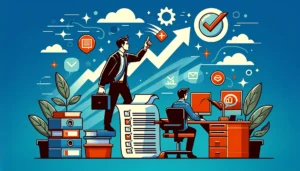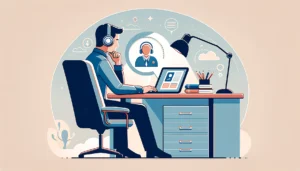Upskilling during the pandemic: reimagining the talent development landscape
- 6 Min Read
HR leaders are rethinking the elements of a successful workforce as the pandemic has demonstrated the need for effective digital transformation to foster efficiency, collaboration and growth
- Author: Alara Basul | Sponsored
- Date published: Dec 9, 2021
- Categories

The concept of upskilling has become synonymous with growth and development. The uncertainty of the pandemic has emphasised the need for digital-centric solutions in order to enhance employee engagement and promote a culture-focused approach to help employees excel in the workplace.
As businesses continue to steer their organisations through uncertainty, HR leaders have had to reimagine the office environment to reflect their staff’s preferences for development and career growth as well as a successful hybrid working environment.
The impact of the pandemic on upskilling
With many businesses turning to remote working over the past year, upskilling has been imperative to transition from on-site work locations in order to keep productivity high.
Upskilling entails learning new skills and identifying skill gaps and, if it’s done effectively, it can foster innovation, boost employee engagement and reduce turnover.
According to a recent PwC survey, 77 percent of workers in 19 countries, including the US, said they are ready to learn new skills or retrain to remain employable in the future.
Meanwhile, a recent PwC Future of Recruiting report found that 37 percent of respondents cited upskilling opportunities as the most important factor when deciding about a new job. The same percentage are even willing to take a pay cut for a chance to learn new skills.
“The pandemic has shed some light on potential skills gaps in the modern workforce,” says Justin Hall, workforce transformation leader and Principal at PwC US. “However one thing is very clear: there’s a direct correlation between upskilling and career development. Upskilling is a fantastic equaliser to encourage greater diversity and create new opportunities within the workplace.”
Ann Johnston, another workforce transformation leader and Principal at PwC US, also believes that by utilising internal capabilities, employees not only become more valuable to their employer, but also to their future employers as well.
“Upskilling is imperative for growth, promoting diversity, and developing a growth mindset to take on new challenges. This will not only boost learning capabilities but also allow employees to evolve in their career,” she adds.
From vision to execution: creating a skilled hybrid workforce
Companies worldwide have had to transform their businesses to create a hybrid working model. This approach has generally been effective in keeping the business going during the pandemic, and it’s become popular with workers who embraced the new freedom of working from anywhere.
However, this enormous shift has highlighted the importance of digital technologies as businesses continue to rely heavily on new solutions such as communication, planning and video conferencing platforms.
HR leaders have also had to step away from manual operations and focus on strategic initiatives to help businesses survive and thrive.
“HR practitioners have too long focused on manual and tactical processes. The rise in technology has automated and accelerated processes to get a better understanding of the bigger picture and provide the right tools to support the change in working styles,” says Hall.
And working preferences, according to PwC’s Pulse recent survey of the US workforce, are all over the map. While 19 percent of workers want to be fully remote, 22 percent want to be in an office full-time. The key takeaway is that people want flexibility and equal access to resources. Hybrid working environments can help tackle these varying needs. And nearly a third of CHROs are taking on this challenge as a top priority that can also address the challenges of retention in midst of The Great Resignation.
Johnston believes that the key to success in hybrid working environments lies in building dynamic capability models to paint a better picture of how the business can thrive.
“It’s about the continual evolution of understanding the working components of a successful hybrid environment. It will look different to each business, but it’s about understanding the evolution, the technical skills required, and leveraging communication platforms to promote transparency,” she says.
“It’s also vital for business leaders to create clear roadmaps and deliverables to build impact and encourage collaboration.”
A sea change of behaviour: building engagement and collaboration
Setting the precedent around the capabilities of new technologies and committing budgets to support employees with the tools they require is a key factor to boost productivity and engagement.
Internal communication and adopting a growth mindset are also imperative to support a successful outcome and strengthen collaboration.
“Growth mindset and agility help employees pivot quickly and craft their careers in ways that allow them the flexibility to move forward, potentially into new emerging areas,” says Johnston.
HR leaders should also understand where their employees are with learning experiences and utilise technology to help them excel.
“A key component to adapting to change is to keep the communication going. The approach isn’t novel anymore; it’s now the application of the approach in the new area of the workforce. All of these can be understood through people analytics and feedback to turn the approach into action,” adds Johnston.
Driving better decisions
Hall believes that businesses should focus on understanding the changes in behavior before making any changes.
“In order to do the heavy lifting, there can’t just be one statistic pushing the data uphill. Businesses should rely on people analytics and employee feedback, create dashboards, and ask questions to foster better communication and cultivate the capability around engagement,” he says.
Johnston adds that skill-building is more likely to stick when it’s social. Collectivity can foster the kind of curiosity that contributes to a culture of innovation and collaboration. It’s all about drumming up enthusiasm for digital skill development that translates to business impact.
“As we pursue better collaboration, the notion of collective learning and performance is becoming more and more important. Understanding how groups are working together, their collective behaviours, and how they deliver success is equally as important as measuring employee engagement.
“If businesses are clear about their skill taxonomy and the capabilities for specific roles, they’ll be able to crack the code on development in the organisation.
“It’s moving away from what businesses already know, to what they can know more about.”
To learn more about PwC’s tech-enabled solutions that can help companies upskill their people, click here









